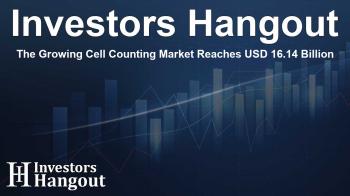The Growing Cell Counting Market Reaches USD 16.14 Billion

Driving Forces Behind Cell Counting Market Growth
The global cell counting market is anticipated to experience remarkable growth, with projections estimating its value to reach USD 16.14 billion by 2029. Initially valued at USD 10.82 billion in 2023, the market is set to grow at a compound annual growth rate (CAGR) of 7.7%. This growth is propelled by several key factors, including significant advancements in technologies, increased research activities, and a growing demand for precision diagnostics. Furthermore, the adoption of automated cell counting solutions, particularly fluorescence-based systems, is on the rise due to their impressive accuracy and efficiency, aided by the integration of artificial intelligence.
Market Segmentation: Products and Applications
The cell counting market can be segmented based on product types into consumables and instruments. The consumables segment, which includes media, sera & reagents, assay kits, microplates, and various accessories, dominated the market in 2023 and is expected to maintain a significant growth trajectory during the forecast period. This is largely due to the increasing emphasis on personalized medicine, stem cell research, and regenerative therapies, all of which require high-quality, tailored consumables.
Research and Medical Applications Driving Demand
In terms of applications, the cell counting market is divided into research applications, medical applications, and bioproduction and quality control. The research applications segment, which includes areas like cancer research, immunology, and neurology, has shown substantial growth potential due to increasing investments in pharmaceutical and biotechnology R&D. The rising focus on advanced research methods is further boosting the adoption of innovative cell counting technologies across various research domains.
Key End Users in Cell Counting Market
Examining the end users of cell counting solutions reveals a diverse landscape including academic and research institutions, hospitals and diagnostic laboratories, as well as pharmaceutical and biotechnology companies. Academic institutes have emerged as dominant players, driven by collaborations between academia and industry aimed at advancing translational research, thereby increasing the demand for effective cell counting solutions. Additionally, the surge in chronic and infectious diseases calls for accurate diagnostic tools, multiplying the need for cell counting in clinical settings.
Geographical Insights: Market Trends
The global reach of the cell counting market is evident as it spans across various regions, including North America, Europe, the Asia Pacific, Latin America, the Middle East, and Africa. North America commanded the largest market share in 2023, with the U.S. leading due to the presence of key players and the high demand for personalized medicine. In contrast, the Asia Pacific region is projected to exhibit significant growth, enhanced by increased investments in healthcare and biopharmaceutical sectors.
Competitive Landscape of the Cell Counting Market
This market is characterized by intense competition among key players such as Danaher Corporation, Thermo Fisher Scientific, and Beckton Dickinson and Company. These companies are consistently pursuing strategies focusing on both organic and inorganic growth. Strategies may include advanced product development, forming partnerships, and acquiring complementary businesses to reinforce their positions within the cell counting market.
Challenges and Opportunities Ahead
Despite robust growth forecasts, the cell counting market is also navigating challenges such as the need for continual innovation and the development of cost-effective solutions. The expanding biopharmaceutical sector presents significant opportunities for companies willing to invest in research and development, cultivating further advancements in cell counting technologies. This aligns with the persistent demand for innovative solutions and improved patient outcomes in the healthcare ecosystem.
Frequently Asked Questions
What is the projected growth rate of the cell counting market?
The cell counting market is projected to grow at a CAGR of 7.7%, reaching USD 16.14 billion by 2029.
Which segments dominate the cell counting market?
The consumables segment currently dominates the market, with significant growth expected from personalized medicine and regenerative therapies.
What are the main applications of cell counting technologies?
Main applications include research fields such as cancer and immunology, along with medical diagnostics and bioproduction quality control.
Who are the leaders in the cell counting market?
Prominent players include Danaher Corporation, Thermo Fisher Scientific, and Beckton Dickinson, who are significantly investing in technological advancements.
How is the geographic landscape evolving in this market?
North America leads the market, while the Asia Pacific region is expected to experience the highest growth due to increased healthcare investment and demand for innovative products.
About The Author
Contact Addison Perry privately here. Or send an email with ATTN: Addison Perry as the subject to contact@investorshangout.com.
About Investors Hangout
Investors Hangout is a leading online stock forum for financial discussion and learning, offering a wide range of free tools and resources. It draws in traders of all levels, who exchange market knowledge, investigate trading tactics, and keep an eye on industry developments in real time. Featuring financial articles, stock message boards, quotes, charts, company profiles, and live news updates. Through cooperative learning and a wealth of informational resources, it helps users from novices creating their first portfolios to experts honing their techniques. Join Investors Hangout today: https://investorshangout.com/
The content of this article is based on factual, publicly available information and does not represent legal, financial, or investment advice. Investors Hangout does not offer financial advice, and the author is not a licensed financial advisor. Consult a qualified advisor before making any financial or investment decisions based on this article. This article should not be considered advice to purchase, sell, or hold any securities or other investments. If any of the material provided here is inaccurate, please contact us for corrections.

